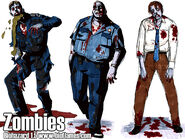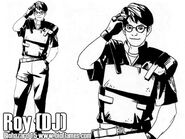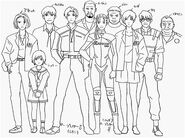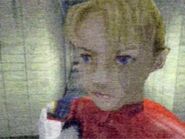Resident Evil 2 began development in 1996 shortly after the original game and was originally scheduled for a March 1997 release.
However, as the game was approaching its release date, the developers were dissatisfied with the resulting product. Rather than releasing a game they were unhappy with, the developers took the risk of cancelling the game and developing the game again from scratch. This cancelled version later became known as "Biohazard 1.5 / Resident Evil 1.5" which is the term given to it by the developers, known widely by the fans.
Story
In the backstory, Umbrella is forced to close after the Mansion Incident when news of their illegal biological experiments was made public. Two months later, a mysterious skin disease begins to spread around Raccoon City, with those dying from it rising as zombies. The Raccoon City Police Department, despite its modern riot defences, soon falls to the infection. The rookie police officer, Leon S. Kennedy, is left as one of the few uninfected officers left in the city. Elza Walker, a college student, stumbles upon the infection while riding her motorcycle into Raccoon City, and also seeks safety in the police department building.
Characters and role

Annette Birkin, Marvin Branagh, and Brian Irons in Resident Evil 1.5.
- Leon S. Kennedy - Leon's role in the game was that of a rookie police officer defending the R.P.D.. Whilst on the roof, the infected enter. At some point he was to escape into the sewers with Ada and Marvin.
- Elza Walker - Elza's role was as a college student returning to Raccoon City after a holiday. At some point, she joins up with John and Sherry where they plan their escape.
- John - One of Elza's supporting character, known as "John" in 1.5. He is a civilian who seeks refuge in the R.P.D. He later became Robert Kendo in the final version of BH2.
- Sherry Birkin - A supporting character for Elza, Sherry would be pursued by William throughout the game.
- Annette Birkin - The mother of Sherry and wife of William.
- Marvin Branagh - Leon's supporting character.
- Ada Wong - Another of Leon's supporting characters, her name was originally "Linda" early in development of 1.5, but was eventually changed to Ada. Linda may have just been a "working" name for development purposes.
- Brian Irons- Chief of the Raccoon City Police Department. Unlike in the final version, Irons was a supporting character who would aid in Leon's story. His office is a lot less morbid in 1.5.
- Roy - Another R.P.D. officer, role and scenario unknown but it is assumed his role was similar to that of Marvin. Judging from available footage, it seems he somehow had connections with John. Roy also had the name of DJ at one point in production.
Enemies
Crows and the Cerberuses share the same role as their Resident Evil 2 counterparts, with the dogs attacking the player in outside areas. Web Spinners were supposed to hide in ventilation tunnels before attacking nearby enemies. William Birkin was to be far more monstrous, able to kill other infected creatures. As evidenced by the little known footage available of the game, in 1.5 William would mention Sherry's name multiple times.
In the prototype, the zombies were significantly more gruesome, continuing to crawl towards the player with their body below the waist severed (it's possible for this to occur in Resident Evil 2, however enemies can only be blasted in half with the Shotgun and it's harder to pull off). In addition, the Zombies could climb on ledges and get up from crawling, which isn't featured in the final version. The various types of zombies were far more varied, including fat zombies, and multiple female zombies.
Two notable enemies in this version which never made it into the final version were a human/spider hybrid and infected baboons.
Scenery
The Raccoon City Police Department was originally conceived with a more modern look; in the release version, it was changed to being an old building re-furbished by the police as a headquarters. To find examples of older buildings, the team snuck into a mansion in Japan to take photographs, deciding that it would be easier than flying to the United States and back.[1]
Weapons
1.5 is said to have had a wide range of weapons at Leon and Elza's disposal. The Remington 870 could be used by both Leon and Elza, and by videos, the shotgun model was to resemble like it did in the first game, but was later changed to the shorter version that was featured in the final release. The SPAS-12 that was fitted with a wooden stock and shot in semi-automatic was set to be another shotgun that was intended to be used by both characters, but was scrapped and (possibly) replaced with the Remington 1100-P. Hand Grenades were also set to be in the game, a weapon that was most likely available to Leon as Elza had the Grenade Launcher. The M202 FLASH was also set to make a return from the first game, but was later replaced by the Stinger rocket launcher. The Flamethrower was also a returning weapon and was available to Leon that was to be found in a locker in the factory. The weapon did in fact make it in the final release, but was relocated to the Laboratory. A metal pipe was set to be second melee weapon in the game, which had longer range of attack and possibly did more damage to enemies than the Combat knife, but was scrapped from the game completely. A Ruger Super Redhawk was set to be the game's magnum, and was weapon available to Leon and (possibly) Elza, but was scrapped and replaced with the Desert Eagle. The MAC-11 was to appear in the game, but it's design in the final release was slightly different, as the silencer didn't possess holes as in the retail version of the game. A HK51 was set to appear, and was supposed to be a second sub-machine gun used by both Leon and Elza, but was scrapped.
The icon of the SPAS-12 was recycled an used for the game Dino Crisis, as the verison with stock of the shotgun.
Development
Initial version

In Resident Evil 1.5, players could control a female protagonist called Elza Walker. The zombies in this early version were less detailed, and the interior of the police station had a more modern design.
Development of Resident Evil 2 began one month after the completion of its predecessor in early 1996,[2] and the first footage of the game was shown at the V Jump Festival '96 in July.[3] This early build, later dubbed Resident Evil 1.5 by producer Shinji Mikami, differed drastically from the released version in its scenario, presentation and gameplay mechanics.[4][5] Its plot followed the same basic outline as that of Resident Evil 2, and featured a zombie outbreak in Raccoon City two months after the events of the first game. In this version of the story, however, Umbrella had already been closed down as a consequence of their illegal experiments.[6] The development team sought to retain the level of fear from the original game, and thus introduced to the narrative two new characters who lacked experience with terrifying situations: Leon S. Kennedy, largely identical to his persona in the final build, and Elza Walker, a college student and motorcycle racer.[5][6][7][8] Unlike the final version, the story paths of Leon and Elza did not cross, and each playable character had two support partners instead of just one.[7] Leon received help from fellow police officer Marvin Branagh and a researcher named Ada while Elza was aided by Sherry Birkin and a man named John, who appeared in Resident Evil 2 as gun shop owner Robert Kendo.[7][9]
Real-world influences had an impact on several character designs by artists Isao Ohishi and Ryoji Shimogama. For example, Ohishi based Leon on his bloodhound, and Annette Birkin was modeled after actress Jodie Foster.[9] The police department in which Resident Evil 1.5 began had a more modern and realistic design, and was smaller than the final building seen in Resident Evil 2.[6][7] There were more encounters with surviving policemen, such as a superior officer of Leon called Roy.[7][9] The number of polygons used for enemy models was far lower than in the released version.[4] This allowed many zombies to appear on the screen, a method of invoking fear in the player that recurred throughout Resident Evil 1.5.[4][5] Furthermore, the game employed dynamic music, and frequently applied alterations to the pre-rendered backgrounds in response to events during the gameplay.[6] The playable characters could be equipped with gear, such as protective clothes that enhanced their defense and enabled them to carry more items.[10][11] The characters' polygonal models were altered by costume changes and by damage received from enemies.[10]
Redesign
The development was carried out by a 40- to 50-person group that would later be part of Capcom Production Studio 4.[4][12] Director and writer Hideki Kamiya led the team, which was composed of newer Capcom employees and over half of the staff from the original Resident Evil.[2][4][5] In the initial stages of development, producer Mikami often had creative disagreements with Kamiya, and tried to influence the team with his own direction. He eventually stepped back to an overseeing role as producer, and only demanded to be shown the current build once a month.[5] Believing the game's assets to be good individually, but not yet satisfactory as a whole, Mikami expected that everything would coalesce in the three months leading up to the projected May 1997 release date.[5][8] Professional screenwriter Noboru Sugimura was tasked with completely reworking the script after initially being consulted on a trial basis, and he suggested to the team that they should start over from scratch. Mikami and others agreed. Shortly thereafter, 1.5 was scrapped at a development stage of 60–80 percent.[2][4][7][13] Mikami later explained that the game would not have reached the desired quality in the aforementioned period, and especially frowned upon the gameplay and locations for being "dull and boring".[2][4][5]
The story of Resident Evil 1.5, with which Mikami planned to end the series, was criticized by supervisor Yoshiki Okamoto, who found it to be too conclusive to allow for future installments. Instead, Okamoto proposed the creation of a fictional universe that would turn Resident Evil into a metaseries – similar to the Gundam and James Bond franchises – in which self-contained stories with common elements could be told.[5] During a period in which the team made no progress rewriting the scenario, Okamoto was introduced to professional screenwriter Noboru Sugimura, who was enthusiastic about the first game's story.[14] Sugimura was initially consulted on a trial basis, but Okamoto was impressed by the ease with which the writer came up with solutions to the problems that plagued the script, and soon asked him to compose the entire scenario for Resident Evil 2.[4][14] One fundamental modification to the story was the reworking of Elza Walker into Claire Redfield, in order to introduce a connection to the plot of the first game.[2] To fulfill Capcom's sales plan of two million copies, director Kamiya tried to attract new customers with a more ostentatious and Hollywood-like story presentation.[15] As Okamoto did not want to simply enforce the new direction, he had Sugimura discuss the plot revisions with the development staff.[5] The planners redesigned the game from the ground up to fit the changes, and the programmers and other remaining members of the team were sent to work on Resident Evil: Director's Cut, which was shipped with a playable preview disc of the new Resident Evil 2 version in order to promote the sequel and to apologize to the players for its belated release.[4][16]
Only a few assets from Resident Evil 1.5 could be recycled, as the principal locations in the final build were made to look more extravagant and artistic, based on photographs taken of the interiors of Western-style buildings in Japanese cities.[4] These environments were created with a software program called O2, and each background took two to three weeks to render. The maximum number of zombies displayed on the screen at one time was limited to seven, making it possible to use 450 polygons for the comparatively detailed models of Leon and Claire.[2] The protagonists, instead of being given visible wounds, were made to limp slowly upon receiving heavy damage.[4] Apart from the graphics, one of the most important new features was the "Zapping System", which was partly inspired by Back to the Future Part II, a time travel-themed film sequel that offers a different perspective on the story of the original film. The voice-overs by the all-Canadian cast of Resident Evil 2 were recorded before the actual cutscenes were completed, with each of the actors selected from a roster of ten people per role.[5] Thereafter, the full-motion videos (FMVs) were created by filming stop motion animations of action figures, which were then rendered to completed pictures with computer graphics (CG) tools.[17] Ada's movie model could not be finished in time. Thus, she is the only main character not to appear in a pre-rendered cutscene.[5]
Several changes had to be made between the regional releases of Resident Evil 2. The North American version contains more violent "game over" screens, which were removed from the Japanese Biohazard 2. Resident Evil 2 was also made more difficult than its Japanese equivalent to prevent rentals from affecting U.S. sales.[2][17][18]
Leon was given an entirely new voice actor in the released version; his damage grunts were recycled to be used by Chris Redfield in the Dual Shock Ver.'s Extreme Battle mode. Ironically, his damage grunts in 1.5 were originally Chris' as place holders from the first Resident Evil.
Gallery
Sources
- ↑ Famitsu interview, 1998
- ↑ 2.0 2.1 2.2 2.3 2.4 2.5 2.6 Hodgson, David (1997). Resident Evil 2 Survival Guide. Gamefan Books. pp. 106A–108A.
- ↑ (in Japanese) Vジャン Vフェス'96ビデオ (Videotape). Shueisha Inc. October 21, 1996.
- ↑ 4.00 4.01 4.02 4.03 4.04 4.05 4.06 4.07 4.08 4.09 4.10 "Resident Evil 2: New In-Depth Interview!". Tips & Tricks (LFP, Inc.) (37). January 1998.
- ↑ 5.00 5.01 5.02 5.03 5.04 5.05 5.06 5.07 5.08 5.09 5.10 (in Japanese) Research on Biohazard 2 final edition. Micro Design Publishing Inc. September 1, 1998. ISBN 9784944000777.
- ↑ 6.0 6.1 6.2 6.3 "Resident Evil 2: The Horror Continues". GamePro (IDG Communications, Inc.) (101): 36–37. February 1997.
- ↑ 7.0 7.1 7.2 7.3 7.4 7.5 Resident Evil Archives. BradyGames Publishing. November 9, 2005. pp. 218–220. ISBN 0-7440-0655-4.
- ↑ 8.0 8.1 The Horror Spreads in Resident Evil 2. Capcom Entertainment, Inc (November 25, 1996). Archived from the original on January 20, 1997.
- ↑ 9.0 9.1 9.2 (in Japanese) Capcom Design Works. Enterbrain, Inc. August 1, 2001. pp. 22–30. ISBN 4-7577-0412-7.
- ↑ 10.0 10.1 Pardi, Daniel. Resident Evil 2 Strategy Guide: Resident Evil Facts. IGN. IGN Entertainment, Inc. Retrieved on August 13, 2010.
- ↑ "In der Mache: Resident Evil 2 – Das Böse kehrt zurück..." (in German). Das offizielle PlayStation Magazin (WEKA Computerzeitschriften-Verlag GmbH) (2/97). February 1997. "Noritaka Funamizu: Wir haben zum Beispiel verschiedene Anzüge für die Spielfiguren integriert. So gibt es einen feuerfesten Overall und einen speziellen Kampfanzug, der das Mitführen mehrerer großer Waffen erlaubt. / For example, we have implemented different suits for the playable characters. There is a fire-proof overall and special combat gear that allows you to carry multiple large weapons.".
- ↑ Production Studio 4 (Japanese). Capcom Co., Ltd. Archived from the original on February 6, 2005.
- ↑ History of Resident Evil. GameSpot. CBS Interactive Inc (November 2, 2004). Retrieved on August 12, 2010.
- ↑ 14.0 14.1 Okamoto, Yoshiki (February 26, 2005). 訃報 (Japanese). Game Republic Inc. Archived from the original on February 3, 2011. Retrieved on August 13, 2010.
- ↑ (in Japanese) Devil May Cry Graphic Edition. Kadokawa Shoten. December 2001. ISBN 9784047070714.
- ↑ (in Japanese) Bio Hazard Perfect Guide: Inside of Bio-Hazard. ASCII Corporation. March 1997. ISBN 4893666592.
- ↑ 17.0 17.1 "An Interview With Shinji Mikami". Resident Evil: The Official Comic Book Magazine (Image Comics, Inc.) (3). September 1998.
- ↑ "An Interview With Shinji Mikami". Resident Evil: The Official Comic Book Magazine (Image Comics, Inc.) (1). March 1998.
| |||||||||||








